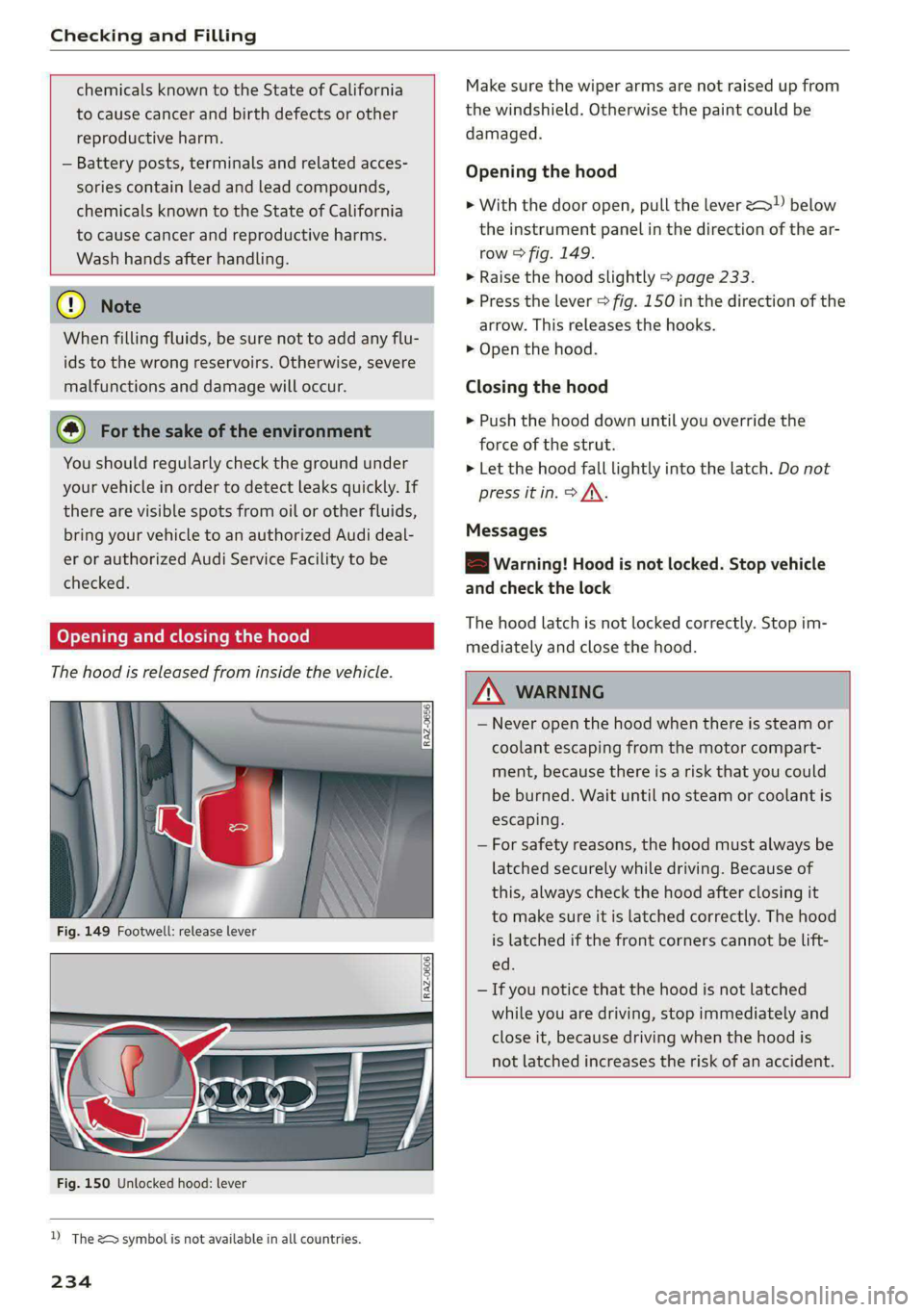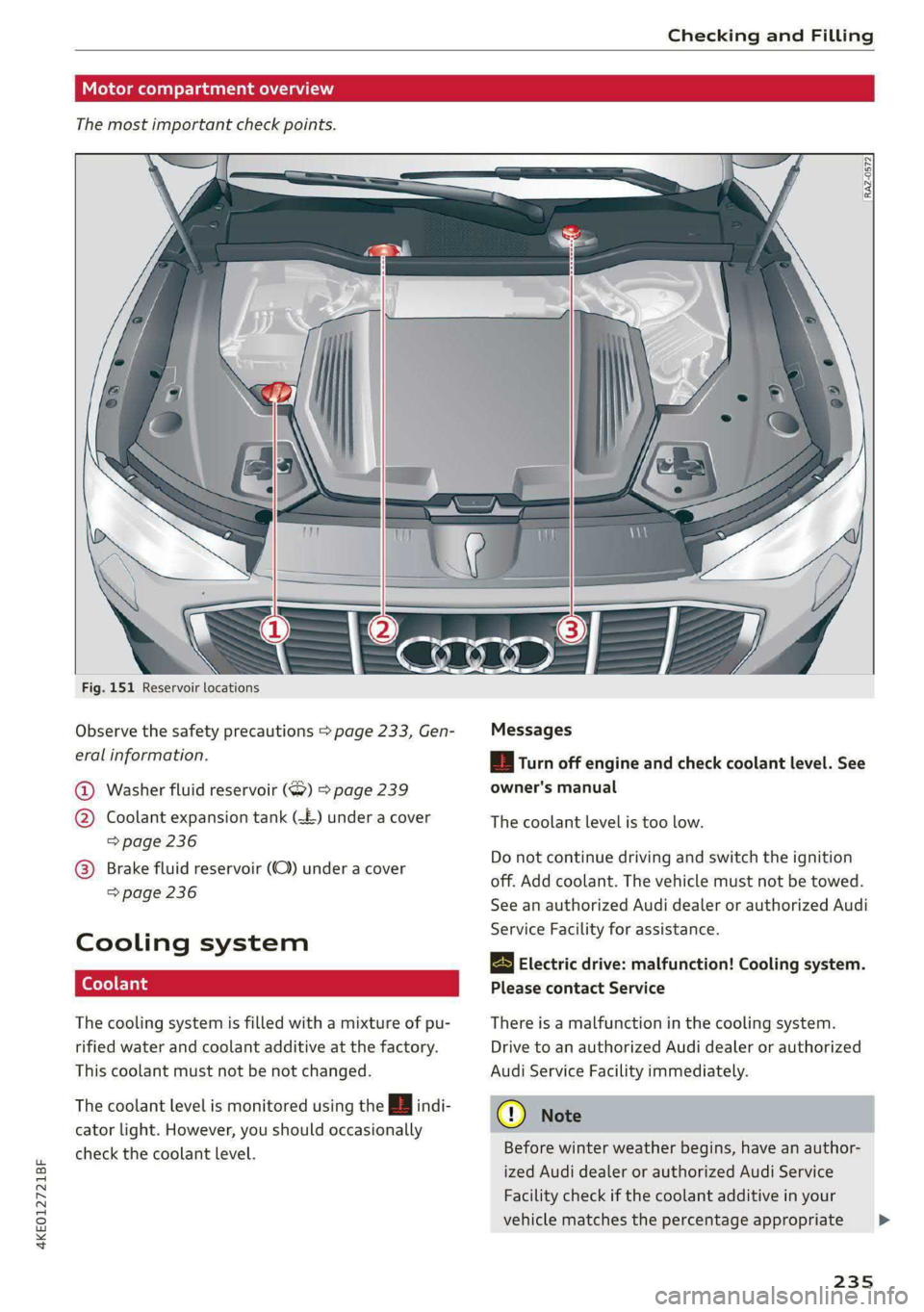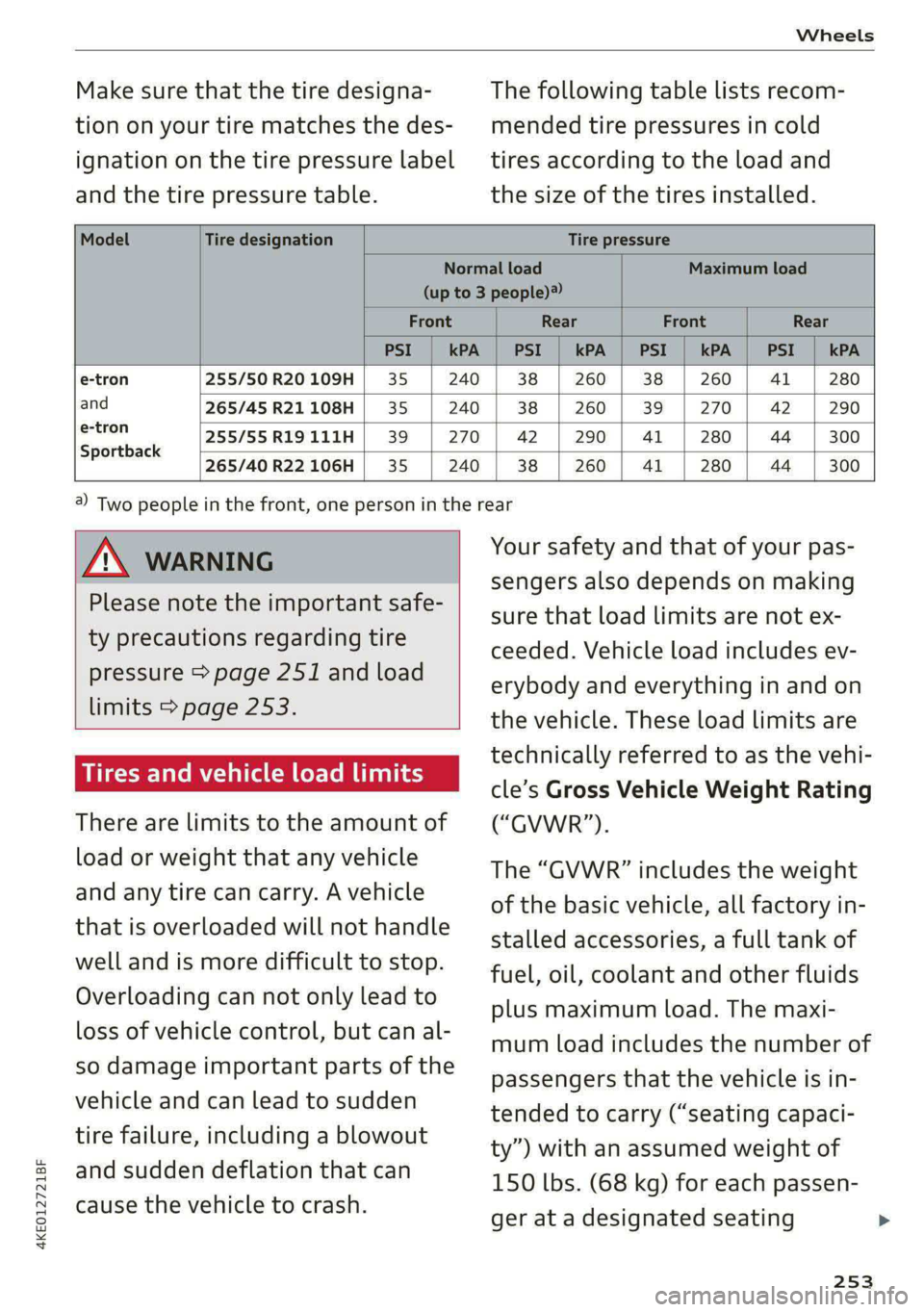coolant fluid AUDI E-TRON 2021 Owners Manual
[x] Cancel search | Manufacturer: AUDI, Model Year: 2021, Model line: E-TRON, Model: AUDI E-TRON 2021Pages: 308, PDF Size: 83.91 MB
Page 235 of 308

4KE012721BF
Checking and Filling
Checking and Filling
Motor compartment
(eT e @eleurlsela)
Special care is required if you are working in the
motor compartment
For work in the motor compartment, such as
checking and filling fluids, there is a risk of in-
jury, scalding, accidents, and burns. For this
reason, follow all the warnings and general
safety precautions provided in the following in-
formation. The vehicle's motor compartment is
a dangerous area. > /\.
Explanation of warnings (sticker in the motor
compartment):
©
Bs
Ay
Always follow the instructions in the op-
OA erating manual.
Hot motor components!
Rotating parts!
The radiator fan can switch on at any
time!
High voltage! The voltage in the high-
voltage system is high enough to cause
fatal injuries. Touching a damaged high-
voltage component can result in a fatal
electric shock.
— The coolant expansion tank cap is equipped
with a seal that must never be removed un-
der any circumstances > page 236. If the
coolant expansion tank is not sealed, con-
tact an authorized Audi dealer or authorized
Audi Service Facility.
— The cap on the coolant expansion tank must
never be opened when the coolant is hot.
The cooling system is under pressure.
—To protect your face, hands, and arms from
hot steam or coolant, cover the cap with a
thick cloth when opening.
— All work on the battery or electrical system
in your vehicle can result in injuries, chemi-
cal burns, accidents, or burns. Because of
this, all work must be performed only by an
authorized Audi dealer or authorized Audi
Service Facility.
— Limit your exposure to chemicals to as short
atime as possible.
Z\ WARNING
— Switch the ignition off.
— Set the parking brake.
— Select the “P” (Park) selector lever position.
— Keep children away from the motor com-
partment.
— Never spill operating fluids in the motor
compartment.
— Avoid short circuits in the electrical system.
— Never open the hood when there is steam or
coolant escaping from the motor compart-
ment, because there is a risk that you could
be burned. Wait until no steam or coolant is
escaping.
— The cap on the coolant expansion tank may
only be opened by an authorized Audi dealer
ZA WARNING
The voltage in the high-voltage system is high
enough to cause fatal injuries. Touching a
damaged high-voltage component can result
in a fatal electric shock. The components in
the high-voltage system are marked with a
warning label which warns of the high-volt-
age.
— The voltage level in the high-voltage system
is still dangerous and potentially life-threat-
ening when the ignition is switched off.
— Never perform work on orange high-voltage
cables or on high-voltage components. Only
authorized repair facilities that are certified
may perform work on the high-voltage sys-
tem.
or authorized Audi Service Facility.
Z\ WARNING
California Proposition 65 Warning:
— Engine exhaust, some of its constituents,
and certain vehicle components contain or
emit chemicals known to the State of Cali-
fornia to cause cancer and birth defects and
reproductive harm. In addition, certain flu-
ids contained in vehicles and certain prod-
ucts of component wear contain or emit
233
Page 236 of 308

Checking and Filling
chemicals known to the State of California
to cause cancer and birth defects or other
reproductive harm.
— Battery posts, terminals and related acces-
sories contain lead and lead compounds,
chemicals known to the State of California
to cause cancer and reproductive harms.
Wash hands after handling.
® Note
When filling fluids, be sure not to add any flu-
ids to the wrong reservoirs. Otherwise, severe
malfunctions and damage will occur.
@ For the sake of the environment
You should regularly check the ground under
your vehicle in order to detect leaks quickly. If
there are visible spots from oil or other fluids,
bring your vehicle to an authorized Audi deal-
er or authorized Audi Service Facility to be
checked.
Opening and closing the hood
The hood is released from inside the vehicle.
RAZ-0606
Fig. 150 Unlocked hood: lever
D_ The & symbol is not available in all countries.
234
Make sure the wiper arms are not raised up from
the windshield. Otherwise the paint could be
damaged.
Opening the hood
> With the door open, pull the lever <> below
the instrument panel in the direction of the ar-
row > fig. 149.
>» Raise the hood slightly > page 233.
> Press the lever > fig. 150 in the direction of the
arrow. This releases the hooks.
> Open the hood.
Closing the hood
> Push the hood down until you override the
force of the strut.
> Let the hood fall lightly into the latch. Do not
press it in. > /\.
Messages
EB warning! Hood is not locked. Stop vehicle
and check the lock
The hood latch is not locked correctly. Stop im-
mediately and close the hood.
ZA\ WARNING
— Never open the hood when there is steam or
coolant escaping from the motor compart-
ment, because there is a risk that you could
be burned. Wait until no steam or coolant is
escaping.
— For safety reasons, the hood must always be
latched securely while driving. Because of
this, always check the hood after closing it
to make sure it is latched correctly. The hood
is latched if the front corners cannot be lift-
ed.
— If you notice that the hood is not latched
while you are driving, stop immediately and
close it, because driving when the hood is
not latched increases the risk of an accident.
Page 237 of 308

4KE012721BF
Checking and Filling
Col kel mel nator Tadnat-lal ae) lav (7
The most important check points.
Fig. 151 Reservoir locations
Observe the safety precautions > page 233, Gen-
eral information.
@ Washer fluid reservoir (>) > page 239
@ Coolant expansion tank (-£) under a cover
=> page 236
@® Brake fluid reservoir (O) under a cover
=> page 236
Cooling system
The cooling system is filled with a mixture of pu-
rified water and coolant additive at the factory.
This coolant must not be not changed.
The coolant level is monitored using the BB indi-
cator light. However, you should occasionally
check the coolant level.
[RAZ-0572
Messages
| Turn off engine and check coolant level. See
owner's manual
The coolant level is too low.
Do not continue driving and switch the ignition
off. Add coolant. The vehicle must not be towed.
See an authorized Audi dealer or authorized Audi
Service Facility for assistance.
Electric drive: malfunction! Cooling system.
Please contact Service
There is a malfunction in the cooling system.
Drive to an authorized Audi dealer or authorized
Audi Service Facility immediately.
©) Note
Before winter weather begins, have an author-
ized Audi dealer or authorized Audi Service
Facility check if the coolant additive in your
vehicle matches the percentage appropriate
235
>
Page 238 of 308

Checking and Filling
for the climate. This is especially important
when driving in colder climates.
Coolant level
Fig. 152 Motor compartment: coolant expansion tank
Observe the safety precautions > page 233, Gen-
eral information.
Checking the coolant level
>» Park the vehicle on a level surface.
> Switch the ignition off.
> Open the hood = page 234.
The coolant expansion tank is located in the ple-
num chamber under a cover. Slide the cover that
is located below the windshield wipers on the
front passenger's side toward the windshield and
remove the cover > page 235, fig. 151.
> Read the coolant level on the floating gauge for
the expansion tank without opening the cap.
The coolant level must be between the Min and
Max markings when the coolant is cold
> fig. 152
> vi turns on, do not continue driving
=> page 235.
> If the coolant level is just over the Min marking,
drive to an authorized Audi dealer or authorized
Audi Service Facility immediately.
Coolant loss usually indicates that there is a leak.
Immediately drive your vehicle to an authorized
Audi dealer or authorized Audi Service Facility
and have the cooling system inspected.
ZA WARNING
— The motor compartment in any vehicle is a
potentially dangerous area. Before perform-
ing work in the motor compartment, switch
236
the ignition off and allow the cooling system
to cool down. Always follow the information
found in > page 233, General information.
— Never open the hood if you can see or hear
steam or coolant escaping from the motor
compartment. This increases the risk of
burns. The cooling system is under pressure.
When you no longer see or hear steam or
coolant escaping, you may open the motor
compartment with caution.
— The coolant expansion tank may only be
opened and filled by an authorized Audi
dealer or authorized Audi Service Facility.
— The coolant expansion tank cap is equipped
with a seal that must never be removed un-
der any circumstances > page 236. If the
coolant expansion tank is not sealed, con-
tact an authorized Audi dealer or authorized
Audi Service Facility.
—When adding coolant, it may leak into the
inside of high-voltage components and
cause a short circuit, increasing the risk of
fire.
— Coolant additive and coolant can be danger-
ous to your health. For this reason, store the
coolant in the original container and away
from children. There is a risk of poisoning.
Brake fluid
BFV-0229|
Fig. 153 Motor compartment: cap on brake fluid reservoir
Observe the safety precautions > page 233, Gen-
eral information.
Checking the brake fluid level
> Slide the cover that is located below the wind-
shield wipers on the driver's side toward the
windshield and remove the cover.
Page 255 of 308

Wheels
Make sure that the tire designa-
tion on your tire matches the des-
ignation on the tire pressure label
and the tire pressure table.
The following table lists recom-
mended tire pressures in cold
tires according to the load and
the size of the tires installed.
Model Tire designation Tire pressure
Normal load Maximum load
(up to 3 people)?
Front Rear Front Rear
PSI kPA PSI kPA PSI kPA PSI kPA
e-tron 255/50 R20 109H 35 240 38 260 38 260 41 280
and 265/45 R21 108H 35 240 38 260 39 270 42 290
e-tron 255/55R19111H| 39 | 270 | 42 | 290 | 41 | 280 | 44 | 300
Sportback
265/40 R22 106H 35 240 38 260 Al 280 44 300
4KE012721BF
Z\ WARNING
Please note the important safe-
ty precautions regarding tire
pressure > page 251 and load
limits > page 253.
Tires and vehicle load limits
There are limits to the amount of
load or weight that any vehicle
and any tire can carry. A vehicle
that is overloaded will not handle
well and is more difficult to stop.
Overloading can not only lead to
loss of vehicle control, but can al-
so damage important parts of the
vehicle and can lead to sudden
tire failure, including a blowout
and sudden deflation that can
cause the vehicle to crash.
@) Two people in the front, one person in the rear
Your safety and that of your pas-
sengers also depends on making
sure that load limits are not ex-
ceeded. Vehicle load includes ev-
erybody and everything in and on
the vehicle. These load limits are
technically referred to as the vehi-
cle’s Gross Vehicle Weight Rating
(“GVWR”).
The “GVWR” includes the weight
of the basic vehicle, all factory in-
stalled accessories, a full tank of
fuel, oil, coolant and other fluids
plus maximum load. The maxi-
mum load includes the number of
passengers that the vehicle is in-
tended to carry (“seating capaci-
ty”) with an assumed weight of
150 lbs. (68 kg) for each passen-
ger at a designated seating
253